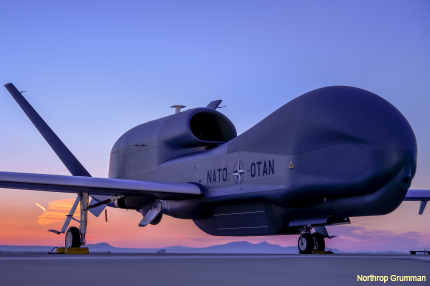NATO gets its first AGS surveillance aircraft
Northrop Grumman and its industry partners deliver the first of five UAS that will be part of a system-of-systems ISR capability.

The AGS Global Hawk on display in Palmdale, Calif.
NATO and manufacturer Northrop Grumman have unveiled the first of five planned Alliance Ground Surveillance (AGS) aircraft, which is intended to expand intelligence, surveillance reconnaissance capability for NATO and allied forces, the company announced.
The AGS is a Global Hawk unmanned aircraft, a high-altitude, long-range system based on the U.S. Global Hawk Block 40 aircraft. The Air Force’s Global Hawks are capable of flying for up to 32 hours at altitudes up to 60,000 feet, with a range of 12,300 nautical miles.
The AGS will be integrated into a broader system-of-systems approach to provide ISR—and support NATO Network Enabled Capability operations—in NATO missions such as protection of ground troops and civilian populations, border control and maritime safety, anti-terrorism activities, crisis management and humanitarian assistance in natural disasters.
"This marks a significant step forward in achieving NATO's goal of acquiring NATO-owned and operated AGS Core Capability," Erling Wang, chairman of the NATO AGS Management Organization, said in the announcement. "What you see here today is the result of one of the commitments made at the 2012 NATO Summit – to bring this advanced and critical persistent ISR capability to the Alliance to help ensure we can continue to address the range of challenges our member and other allied nations face."
In addition to four more Global Hawks, the program covers fixed, mobile and transportable ground stations. "We are establishing the necessary ground stations, command and control systems, and training and logistics support services at the NATO AGS main operating base at Sigonella Air Base in Italy," said Jim Edge, general manager of NATO’s AGS Management Agency.
Northrop leads an international team of companies from 15 countries. All 28 NATO nations will contribute to long-terms support of the program.



